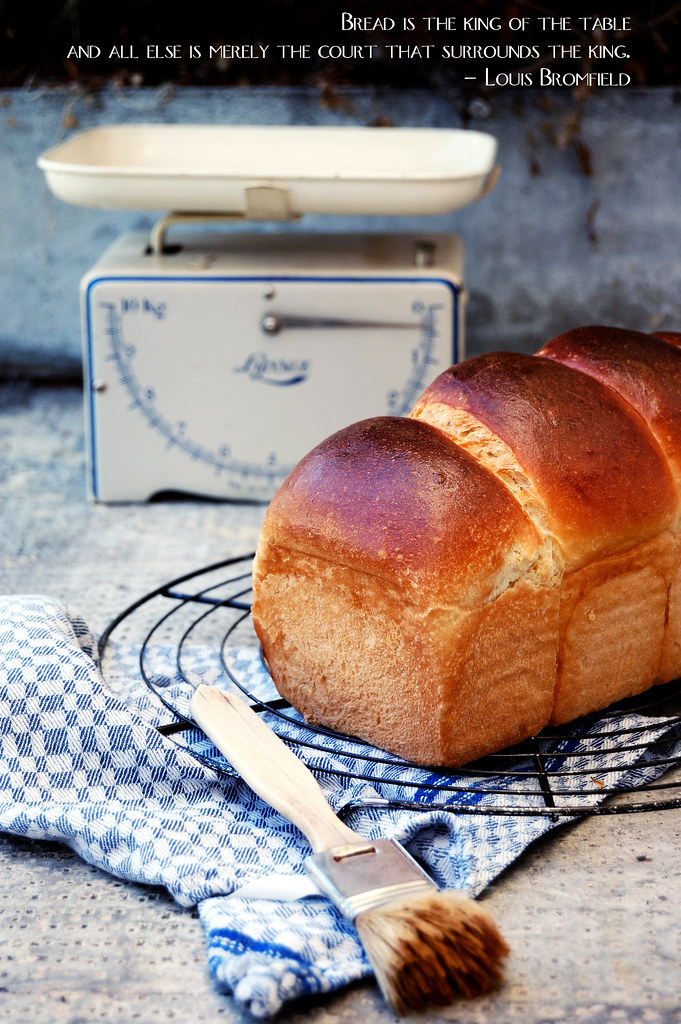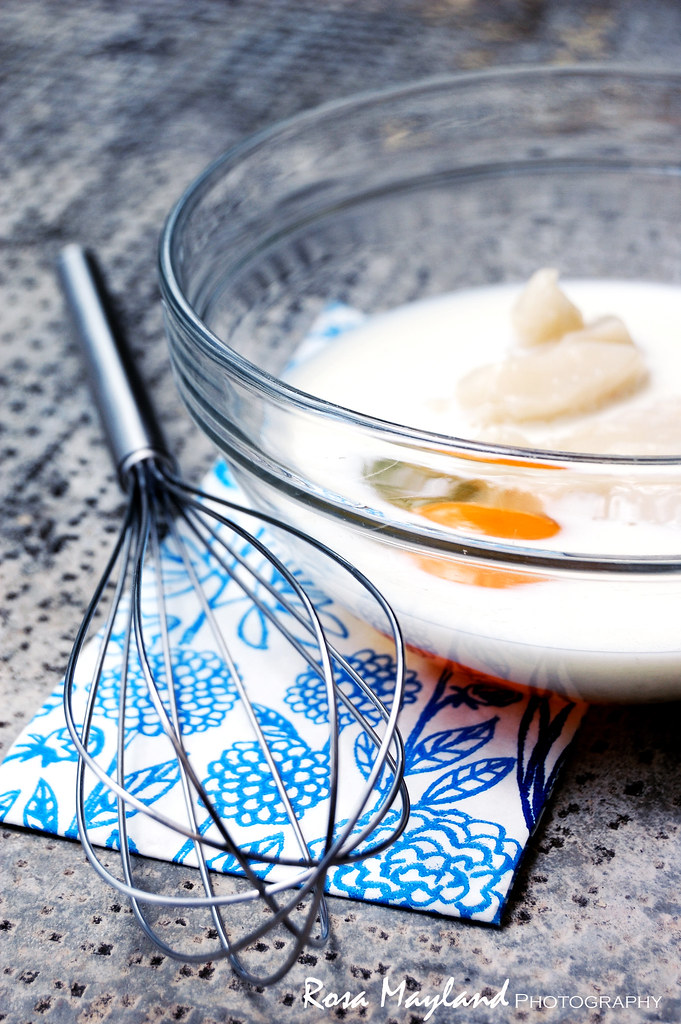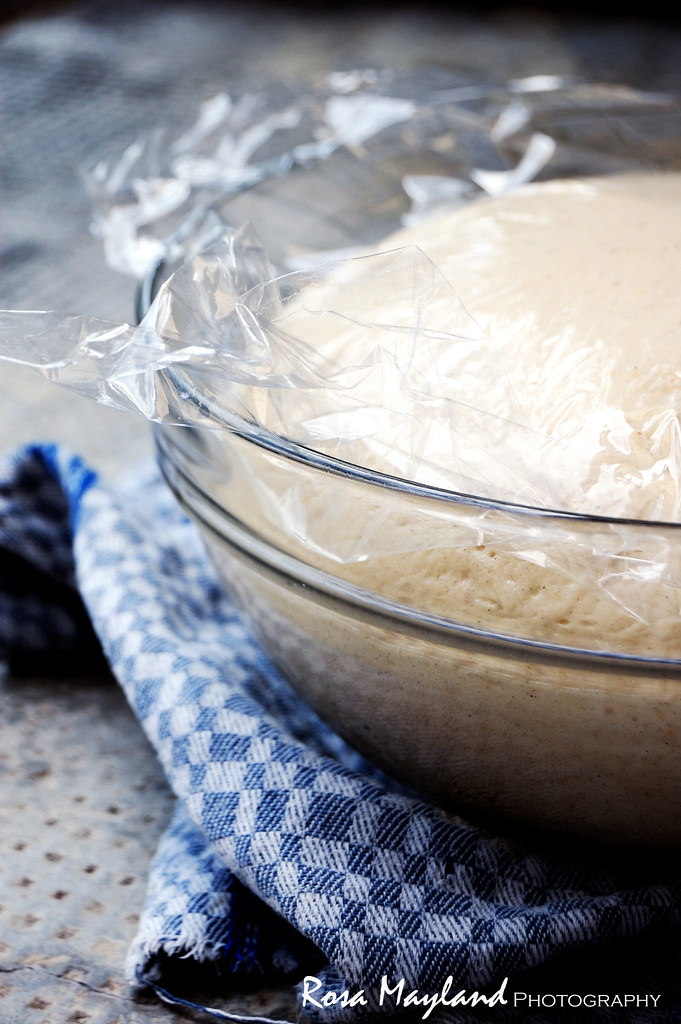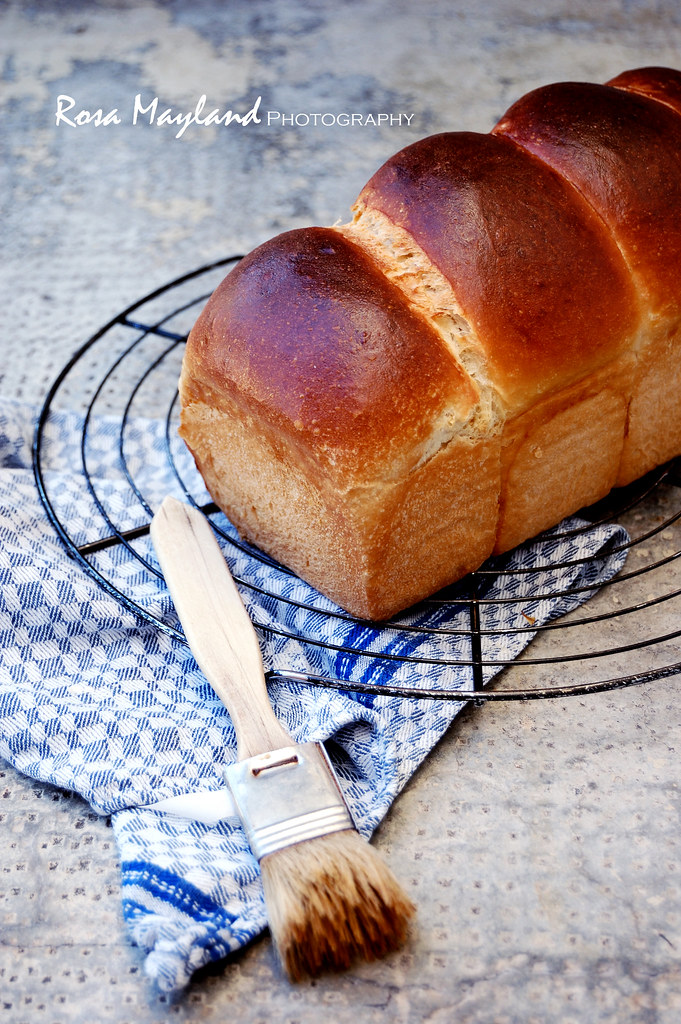At the moment, I
regularly receive e-mails from bloggers who ask me to write posts for them. It
is certainly a pleasant sensation to know that you are”notorious”, but the
downside of it is that, as a consequence, the
requests have been piling up lately and I have the impression that I’m
slowly drowning in them. Dealing with them is hard, because Rosa’s Yummy Yums is currently keeping
me busy and to make things worse, coping with the way weeks pass (too fastly)
is already challenging enough. Anyway, although it usually takes me quite a
while before I am able to grant my consorts’ demands, I nonetheless always try
to please my foodie buddies by offering them the best of myself as a token of
respect and appreciation.
So, when Anuradha at Baker Street proposed me to show her how straightforward it is to toil with yeast and
help her get rid of her uneasiness when it comes to handling this seemingly
treacherous leavening agent, I could not refuse her proposition. As a fellow
gastronome and kitchen dweller, it is my duty to encourage my Indian friend to
take the bull by the horns and turn her into a confident dough puncher.
If you have never heard
of Anuradha before, then you have missed out a lot as not only is she a
talented and self-taught baker, but also the kind soul behind the highly
popular Muffin Monday event.
Her brilliant site is chock-a-block full with cool recipes for cakes, cookies,
bars, cupcakes, cheesecakes, etc... It is impossible to browse through Baker Street without feeling the urge to replicate one of her mouthwatering treats. I am
a big fan of hers!
Asians can't live without rice and the majority of white people could not envisage an existence devoid of bread. For most Westerners, it is an important staple which’s consumption can be traced back to the prehistoric era and which has been eaten on a daily basis since the emergence of agriculture. It belongs to those edible goods that form the basis
of all civilizations’ diets due to its significant nutritional properties - poor in fat, but
rich in complex carbohydrates, plant protein, fibers, vitamins and essential minerals
-, cheapness and simplicity.
As an Anglo-Swiss person, it is one of the foods
that is part of my European heritage, thus it has forged my identity and it
characterizes me. An age-old tradition here. For instance, Switzerland is
supposed to have more varieties of breads than any other country on the planet
- between 200 and 300 different kinds - and our nation have been tackling dough
for over 6000 years. Every canton has its own specialities and each celebration its
particular loaf to which a multitude of stories as well as customs are linked.
We are definitely no novices in that department. Great Britain is also very
fond of that doughy aliment and there too, the art of breadmaking has seen the
light of day during the Stone Age. As a matter of fact, it is one of UK's favorite eats - 99% of the
households buy bread and 12 million loaves are sold each day. You'll find many
bakeries across the kingdom and thanks to the vast range of British flour
available, the Queen's subjects have no reason of being jealous of the Helvetic
folks as over 200 types of breads are said to be produced nationwide.
So, if that short introduction made your mouth water and your tastebuds tingle, tickled your curiosity and gave you the urge to read my article, then please hop on over to Baker Street in order to learn more about this "Cardamom & Orange Brioche Bread (Tang Zhong Method)", get a glimpse of my pictures, discover my recipe and pay a visit to the lovely Anuradha.
This bread is getting yeastspotted by Susan’s Yeastspotting!
This bread is getting yeastspotted by Susan’s Yeastspotting!
Etant donné que beaucoup de mes
lecteurs francophones ne comprennent pas forcément l'anglais et que
malheureusement peu d'entre-eux auront la chance de lire mon billet
invité et dernier article en date sur le merveilleux blog Baker Street qui appartient à la tentueuse blogeuse Anuradha, je me
suis permise de traduire la recette qui y figure afin que vous puissiez
aussi en profiter car je pense qu'elle pourra vous intéresser (vous
pouvez tout de même y jeter un coup d'oeil car ses recettes sont
vraiment passionnantes et mon article contient d'autres images que
celles exposées ici).
J'espère que ma "Brioche A La Cardamome Et A L'Orange" vous plaira car c'est un pain divinement moelleux et parfumé dont la méthode de fabrication (Tang Zhong) nous vient tout droit du Japon (les autres pays d'Asie en sont aussi friands) et dont je me suis enamourée dernièrement après l'avoir découvert sur le blog de la merveilleuse Gracianne. Un pur délice!
J'espère que ma "Brioche A La Cardamome Et A L'Orange" vous plaira car c'est un pain divinement moelleux et parfumé dont la méthode de fabrication (Tang Zhong) nous vient tout droit du Japon (les autres pays d'Asie en sont aussi friands) et dont je me suis enamourée dernièrement après l'avoir découvert sur le blog de la merveilleuse Gracianne. Un pur délice!
Recette adaptée de "Un Dimanche A La Campagne" et de "Kirbie's Cravings".
Pour un pain.
Ingrédients Pour Le "Tang Zhong":
25g de Farine
125g d’Eau (filtrée de préférence)
Ingrédients Pour La "Pâte":
125g (125ml) de Lait
120g de Tang zhong
1 Oeuf (63g)
350g de Farine T55
50g de Sucre cristallisé
1 CS de Lait en poudre
1 1/4 CC de Cardamome en poudre
Le zeste d'une demi orange (ou 1 sachet de zestes d'orange Dr. Oetker)
1 1/2 CC de Levure en poudre (ou 15g de levure fraîche)
1 CC de Sel de mer fin
30g de Beurre non-salé, coupé en petits cubes, à température ambiante
1 CS d'Huile d'arachide, pour huiler le bol
1 Oeuf + 1 CS de Lait, pour le glaçage
Méthode Pour Le "Tang Zhong":
1. La veille, mélanger dans une casserole, au fouet, 25g de farine et 125g d’eau. Laisser chauffer à feu moyen en fouettant constamment jusqu’à obtention d'un mélange ayant la consistance d’un roux. En principe, il faut le faire chauffer jusqu’à 65ºC pendant 2-3 minutes (dès que le mélange épaissit, devient homogène et que le fouet y laisse un sillage, il est prêt).
2. Verser le Tang Zhong dans un bol, le laisser refroidir, filmer au contact et réfrigérer pendant au moins 6 heures.
Méthode Pour La "Pâte":
3. Le lendemain, remettre le Tang Zhong au moins une demi-heure à température ambiante avant de l’utiliser.
4. Dans un bol moyen, fouetter ensemble le lait, le Tang Zhong et l’œuf.
5. Dans le bol de votre robot, mélanger ensemble la farine, le sucre et le lait en poudre.
6. Faire un puits, ajouter le mélange liquide, la cardamome, le zeste et la levure sèche (ou la levure fraîche émiettée), puis commencer à pétrir.
7. Au bout de quelques minutes, ajouter le sel puis pétrir pendant encore 5-10 minutes, jusqu’à ce que la pâte soit bien élastique et homogène.
8. Ajouter ensuite le beurre mou et pétrir de nouveau pendant 10 minutes, jusqu’à ce que la pâte prenne du corps et se détache des parois du bol.
9. Façonner la pâte en une boule et la placer dans un grand bol que vous aurez préalablement huilé. Couvrir la pâte avec un film plastique et recouvrir le bol d'un linge humide. La laissez lever dans un lieu chaud et à l'abri des courants d'airs, jusqu'à ce qu'elle ait doublé de volume, environ 40 minutes à 1 heure.
10. Dégonfler la pâte, la transférer sur une surface propre et légèrement farinée, puis la façonner en un pain rectangulaire (voire méthode - vidéo en anglais) ou la diviser en 3 parts égales, applatir chaque portion avec vos mains pour en chasser l'air, les bouler (voire méthode - vidéo en anglais) et les déposer côte à côte dans le moule.
11. Couvrir d'un film plastique et laisser lever pendant environ 40 à 60 minutes ou jusqu'à ce que la pâte ait doublé de volume.
12. Préchauffer le four à 180 ° C (350 ° F), puis battre un oeuf avec 1 cuillère à soupe de lait et badigeonner le dessus du pain avec ce mélange (la croûte deviendra dorée et brillante).
13. Verser 1/4 - 1/2 tasse d’eau dans le fond du four chaud et cuire pendant environ 30 minutes, ou jusqu'à ce que le pain sonne creux lorsque vous tapez sur sa base avec un doigt.
14. Laisser refroidir sur une grille.
1 Oeuf + 1 CS de Lait, pour le glaçage
Méthode Pour Le "Tang Zhong":
1. La veille, mélanger dans une casserole, au fouet, 25g de farine et 125g d’eau. Laisser chauffer à feu moyen en fouettant constamment jusqu’à obtention d'un mélange ayant la consistance d’un roux. En principe, il faut le faire chauffer jusqu’à 65ºC pendant 2-3 minutes (dès que le mélange épaissit, devient homogène et que le fouet y laisse un sillage, il est prêt).
2. Verser le Tang Zhong dans un bol, le laisser refroidir, filmer au contact et réfrigérer pendant au moins 6 heures.
Méthode Pour La "Pâte":
3. Le lendemain, remettre le Tang Zhong au moins une demi-heure à température ambiante avant de l’utiliser.
4. Dans un bol moyen, fouetter ensemble le lait, le Tang Zhong et l’œuf.
5. Dans le bol de votre robot, mélanger ensemble la farine, le sucre et le lait en poudre.
6. Faire un puits, ajouter le mélange liquide, la cardamome, le zeste et la levure sèche (ou la levure fraîche émiettée), puis commencer à pétrir.
7. Au bout de quelques minutes, ajouter le sel puis pétrir pendant encore 5-10 minutes, jusqu’à ce que la pâte soit bien élastique et homogène.
8. Ajouter ensuite le beurre mou et pétrir de nouveau pendant 10 minutes, jusqu’à ce que la pâte prenne du corps et se détache des parois du bol.
9. Façonner la pâte en une boule et la placer dans un grand bol que vous aurez préalablement huilé. Couvrir la pâte avec un film plastique et recouvrir le bol d'un linge humide. La laissez lever dans un lieu chaud et à l'abri des courants d'airs, jusqu'à ce qu'elle ait doublé de volume, environ 40 minutes à 1 heure.
10. Dégonfler la pâte, la transférer sur une surface propre et légèrement farinée, puis la façonner en un pain rectangulaire (voire méthode - vidéo en anglais) ou la diviser en 3 parts égales, applatir chaque portion avec vos mains pour en chasser l'air, les bouler (voire méthode - vidéo en anglais) et les déposer côte à côte dans le moule.
11. Couvrir d'un film plastique et laisser lever pendant environ 40 à 60 minutes ou jusqu'à ce que la pâte ait doublé de volume.
12. Préchauffer le four à 180 ° C (350 ° F), puis battre un oeuf avec 1 cuillère à soupe de lait et badigeonner le dessus du pain avec ce mélange (la croûte deviendra dorée et brillante).
13. Verser 1/4 - 1/2 tasse d’eau dans le fond du four chaud et cuire pendant environ 30 minutes, ou jusqu'à ce que le pain sonne creux lorsque vous tapez sur sa base avec un doigt.
14. Laisser refroidir sur une grille.
Remarques:
Au départ la pâte sera extrêmement collante. C'est tout à fait normal. Continuer à la pétrir jusqu'à ce qu'elle soit élastique et lisse, pendant environ 15-20 minutes avec un batteur sur socle et à 30 minutes à la main.
Au départ la pâte sera extrêmement collante. C'est tout à fait normal. Continuer à la pétrir jusqu'à ce qu'elle soit élastique et lisse, pendant environ 15-20 minutes avec un batteur sur socle et à 30 minutes à la main.
Quand la pâte est prête, vous devriez être capable de l'étirer qu'elle se déchire trop rapidement.
Suggestions d'accompagnement:
Servir pour le déjeuner ou le brunch avec du fromage, de la confiture, du Nutella ou la tartinade de votre choix.
Cette brioche est parfaite pour faire un pouding au pain ou du pain perdu.
Suggestions d'accompagnement:
Servir pour le déjeuner ou le brunch avec du fromage, de la confiture, du Nutella ou la tartinade de votre choix.
Cette brioche est parfaite pour faire un pouding au pain ou du pain perdu.





























